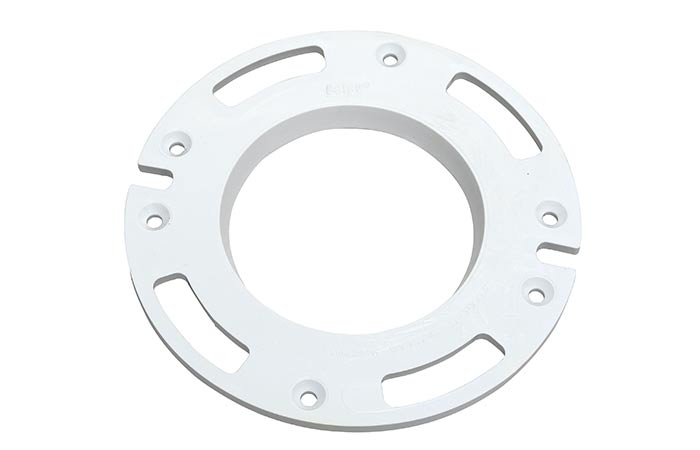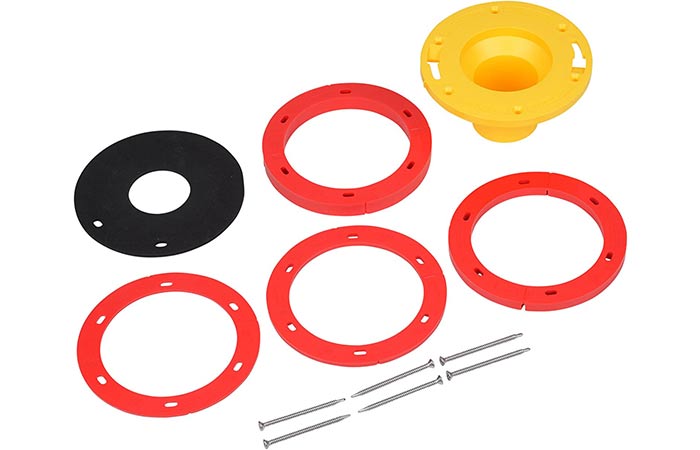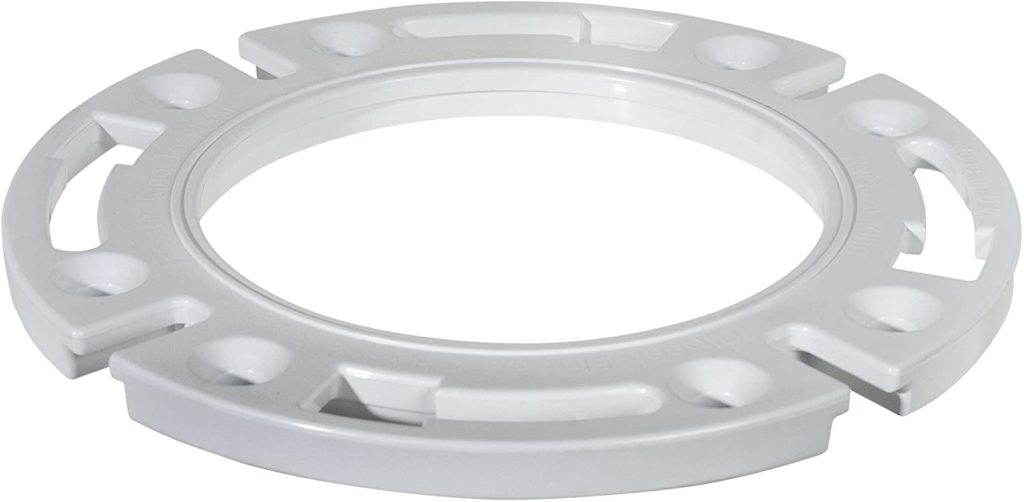Toilet Flange Extender Guide
Installation of Toilet flange extenders is one of the most efficient ways to fix the problem of a toilet flange that sits too low.
A toilet flange that is too low is a common issue that usually occurs after reinstalling a new bathroom floor. That is, installing a thicker flooring material than the previous one, causing the toilet flange to be too low.
There are other factors that can cause the flange to sit too low, but regardless of the cause, this plumbing fault is a health hazard because it causes toilet water leakage and a bad odor around the base.
This is where toilet flange extender comes in handy. Being one of the most effective ways to raise the toilet flange, hereby find more about what a toilet flange extender is, how it works, how to install/replace one and a review of the best.
What is a Toilet Flange Extender & Purpose?
A toilet flange extender is a piece of hardware used to lengthen the drain pipe connection to a toilet. In other words it is used to raise the height of the old flange.

It is designed to fit over an existing flange and raise the drain connection above the surrounding flooring. A toilet flange extender, which is commonly used when installing a new bathroom floor, allows a toilet to be raised while still connecting to the main sewer pipe to create a solid conduit path from the bowl horn to the toilet flange.
The extender ensures that the bottom of the toilet, the wax ring, and the flange all align properly. When the existing flange is too low to hold the wax ring in the proper position to meet the bottom of the toilet drain, a flange extender is required.
The toilet flange extender serves a dual purpose in that it not only connects to the sewer but also connects the toilet to the floor. This flange houses the two connecting bolts that hold the toilet to the floor. The flange is screwed to the floor, which prevents the assembly from moving once it is in place.
Further Reading: Toilet Flange too High/Low-Causes & Fixes
How to Install a Toilet Flange Extender
What you’ll need
- Rubber gloves
- Bucket
- Old rag or sponge
- Adjustable wrench , spanner or pair of pliers
- Silicone sealant
- New extender
Step #1 Test Fit the Flange Extender
The first step in installing a flange extender is to identify one that meets your specifications. There are many different brands and types, so make sure it fits your toilet before gathering the rest of your supplies and learning how to install it. The procedure for installing an extender varies depending on what type of extender used, but it is the same for all.
If one or more spacers are included with the flange extender, make sure it fits properly. The flange extender’s bottom should be flush with the finished floor, or no more than 1/4 inch below or above it.
Step #2 Drain the Water in the Toilet.
Shut off the water supply by turning off the shutoff valve that is usually found on the wall behind your toilet to prevent water from refilling the tank after flushing.
Pour 1/4 cup of toilet bowl cleaner or household bleach into the toilet bowl and flush the toilet to get rid of the water. Finally, you can drain any remaining water in the bowl with a sponge or old towel while squeezing the water into a container or other, you can use a wet vacuum. If you can access one.
After that, disconnect the water supply hose from the bottom of the tank.
Step #3 Remove the Toilet
The tank mounting nuts and bolts can be found on the underside of the toilet base, where the tank is located. loosen and unscrew them using a wrench or spanner.
If the nuts and bolts are corroded and won’t budge with a wrench, lubricate them. If that doesn’t work, try using a hacksaw to cut through the bolts, inserting the blade between the toilet base and the nut. To protect the toilet’s base, place masking tape on the surface near the bolts.
On either side of the toilet’s base, look for the nuts and bolts that hold the toilet to the floor. (If the plastic caps are still on them, remove them.) Use a wrench too, to Loosen and unscrew them.
Remove the bolts with a hacksaw if they are too corroded to unscrew. Keep a rag on hand to wipe up any spilled water.
Standing over the toilet bowl, gently rock it from side to side to loosen the wax ring’s seal, then lift it straight up and level it. Remember that you won’t be able to reuse the ring once you’ve removed the toilet.
Remove the toilet from the floor, the toilet from the drain, and place it in a secure area of your bathroom or another part of your home on cardboard or old towels. then pry the toilet away from the flange with care. When removing or moving a toilet, be careful because the porcelain is fragile and can break.
To make moving easier, you can separate the tank from the toilet bowl.
Step #4 Clean the Flange.
Scrape away any old wax from the flange with a putty knife or any flat metallic blade that isn’t too sharp to avoid damaging the surface.
Wipe away any remaining residue with mineral spirits and a soaked rag.
Cleaning the old flange is necessary to ensure that the flange extension kit sits neatly and securely in place.
Step #5 Install the Flange Extender
Remove any screws that hold the old flange in place on the subfloor. The flange extender will most likely be secured using some or all of these screw holes. The majority of extenders are secured to the subfloor with screws driven through the old flange’s holes.
Apply a generous amount of silicone caulk to the flange extender’s bottom lip. Alternatively, if the flange extender comes with a rubber gasket, install it according to the manufacturer’s instructions. Place the flange extender over the old flange, including any spacers that may be required.
Align the extender’s screw holes with the old flange’s open holes. Using the provided screws, secure the extender to the subfloor.
Slide the bolts back into the holes you removed them from, taking note of the notch and groove on both sides of the flange, which allows the wide end of the bolts to fit into the flange. Also, keep in mind that the bolts should be evenly spaced across each other. Finally, slide the extender down over the bolts, ensuring that it rests flat on top of the gasket.
Step #6 Reinstall the Toilet
You can now replace the toilet after installing the flange extender. When reinstalling the toilet, it’s best to use a new wax ring. Set the toilet using a deep-seal wax ring fitted to the horn of the toilet when using an extender.
Lift the toilet and check that the bolts in the flange are aligned with the holes in the toilet’s base. Lower the unit to the floor by placing it straight over the bolts. It’s best to press it down rather than rock it, as this can damage the wax ring’s seal. Place the nuts on the bolts and use a wrench to tighten them just enough. Turn the water supply back on and reconnect the waterline.
Run a thin layer of silicone sealant along the seam between the toilet’s base and the floor once it’s in place.
Best Toilet Flange Extenders
Set Rite Toilet Flange Extender

This is the most popular flange extender used by most DIYers and plumbers. Most users agree that the Set Rite toilet flange extender is sturdy, easy to install and provides value for money.
It is a complete toilet flange extender repair kit that extends from from 1/4 to 1-5/8 to finished floor. It
works underneath and on top of your toilet flange.
It is also code approved – water & gas tight seal
Sioux Chief Mfg Closet Flange Extension

Another alternative to extend existing flange when added subfloor or tile leaves flange at or below floor level is the Sioux Chief closet extension ring kit
- Ring can be stacked if needed
- Includes 7/16-Inch closet flange extension ring and two closet bolts
How to Choose the Right Toilet Flange Extender
The following are some factors to consider when buying a toilet flange extender.
The first step to installing a flange extender is finding an extender that fits your situation. There are many different brands and types, so you should make sure that during your purchase you find an extender that is compatible with the pre-existing flange that is in place.
Flange extenders come in a variety of thicknesses, allowing you to raise the toilet flange height by several inches. As a result, you should select an extender that covers the gap in height and creates a watertight seal.
Most extenders include some spacers, which can be stacked to raise the flange as needed.
Only if you can create a watertight seal between the drainage system’s lower and upper sections will a flange extender work. This is why most extenders come with a rubber gasket; if yours doesn’t, you’ll have to seal the fixture with caulk or a wax ring.
Because toilet flange extenders come in a variety of materials, you should pick one that you like and that is appropriate for the task at hand. That is, one that is compatible with the flange that already exists.
Flange extenders are made of a variety of materials, but the most common is durable plastic, which can be used with the existing stainless steel, ABS, cast iron, and PVC flanges.
Finally, durability is an important factor to consider when purchasing a toilet flange extender.
A toilet flange’s durability is determined by a variety of factors, including the material and brand name, among others.
Metallic flange extenders can be less durable than synthetic ones because they are used in wet environments and come into contact with toilet waste on a regular basis or corrosives from cleaners, making them vulnerable to damage. As a result, choose a higher-quality material to extend the life of your extender and ensure a watertight fit.
Furthermore, certain features improve the efficiency and durability of your flange extender. An extender with a stainless steel ring, for example, lasts longer and is less susceptible to damage than one made of standard plastic, when subjected to twisting and compression.
Metal Toilet Flange Extenders vs Plastic/Rubber
Plastic Extenders
Plastic extenders include a new flange attached to a short pipe that seals the existing flange with a gasket on the inside. They also include a number of spacers.
The spacers can be stacked, so a plastic extender is ideal for raising a toilet flange by more than two inches.
If your plumbing is iron cast, you’ll probably need to order a special gasket because most of these extenders only work with 3-inch or 4-inch plastic pipes.
Extenders made of plastic (PVC) are good because they are resistant to corrosion and rusting and last a long time, but the material is a disadvantage because plastic is prone to breaking when stressed.
Rubber Extenders
Toilet flange extenders made of rubber are commonly used in situations where the gap between the toilet flange and the toilet drain connection is small. Because rubber is compressible, they are typically thick to accommodate different sized gaps.
As a result, when the rubber flange is compressed between the two, it forms a perfect watertight seal, preventing water from leaking.
These flange extenders are ideal if the space to be filled is less than half an inch and the existing toilet flange is in good condition. They work similarly to wax rings in sealing your toilet.
Rubber flanges are good because they make perfect watertight seals due to their compressibility but their disadvantage lies on the advantage too. Over time rubber adapts to the compression and adjusts to the form thus there is no more compression which can lead to leaking.
Rubber is also prone to corrosion and damage from some cleaning agents that are flushed from the bowl.
Metal Flange Extenders
More expensive hybrid extenders are made of metal with wax-free rubber seals. The most commonly used metal is stainless steel, which is preferred due to its strength, durability, and resistance to deformities. Rubber gaskets are required for metal flange extenders.
Furthermore, rather than spacers, they typically have ‘feet’ protruding down the old surface, which can be quite useful with a deformed old flange or one that can no longer hold bolts.
The metals used are rust resistant but can react with cleaning chemicals flushed down the drain. However metal extenders have the advantage of strength and resistance to deformities.
Toilet Flange Spacer vs Extender
A toilet flange extender is a piece of hardware that fits over an existing flange to raise the drain connection above the flooring. Extender is simply a “funnel” that creates a solid conduit path from the bowl horn to the toilet flange.
Some flange extenders are plastic rings of varying thicknesses, while others are similar to standard floor flanges but have a shorter pipe stub that fits inside the opening of the existing flange.
A spacer, on the other hand, is a device or piece that is used to create or maintain a desired amount of space (as between two parts). Similarly, a toilet flange spacer ring is used to separate the toilet flange from the toilet. Toilet flange spacers are available in a variety of hard PVC ring thicknesses.
These rings are intended to be stacked in any combination to match the new floor surface level. Some kits also include a toilet flange extender.
Toilet flange Spacers are typically used in conjunction with toilet flange extenders to achieve the desired height.
A toilet flange extender is an adapter that is used to add height (extend) to the pre-existing toilet flange to raise its level. A spacer on the other hand, is a ring with shape and top features of an extender but their purpose is to raise flange or flange extender height by stacking them on top of each other.
Toilet flange extenders come in a variety of materials, That is, metal , plastic and rubber while flanger spacers on the other hand, are made of plastic(PVC), that come in different thicknesses to accommodate different flange heights.
Most toilet flange extenders can be used independently without the need of adding spacers, that is, they use only rubber gaskets or wax rings.
Spacers on the other hand, are hardly used independently and come in handy by being stacked on top of flange extenders to add height.
Both toilet flange spacers and extenders are used to raise the height of the existing toilet flange to ensure compatibility and prevent leaks
Both pieces of hardware require the use of rubber gaskets in connection points to prevent leaking.
Further Reading